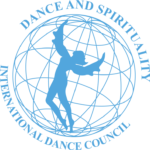COTE D'IVOIRE
The “sacred dances” are never shown to the “uninitiated”, whether European or African; only the spectacular part is exhibited in public. In the west of the country, the dance of the stilt walkers, practiced by the Dan, and the juggling of the Guérés, who throw little girls falling between two daggers, are the most famous and the most spectacular. In the north, the Senufo practice the n’goro dance and the dance of the panther-men, or Boloy dance. The Senufo dance called balafon is also practiced in Ivory Coast.
To understand the ethnic groups of Ivory Coast it is absolutely necessary to attend the initiation ceremonies, the rituals animated by dances and the sounds of drums, flutes and gourds used as musical instruments .
REFERENCES
WIKIPEDIA
TRANSAFRICA.BIZ
NOTE
Mrs BLAGONE Lou Sellou Nadège, CID Member, choreographer and dance teacher, founder of the KAHAFLA-FÊ-FESTIVAL, festival of arts, cultures and gastronomy of the Gouro people will give us more information on Cote d ‘Ivoire’s sacred dances
List of Dances
Abissa (festival)
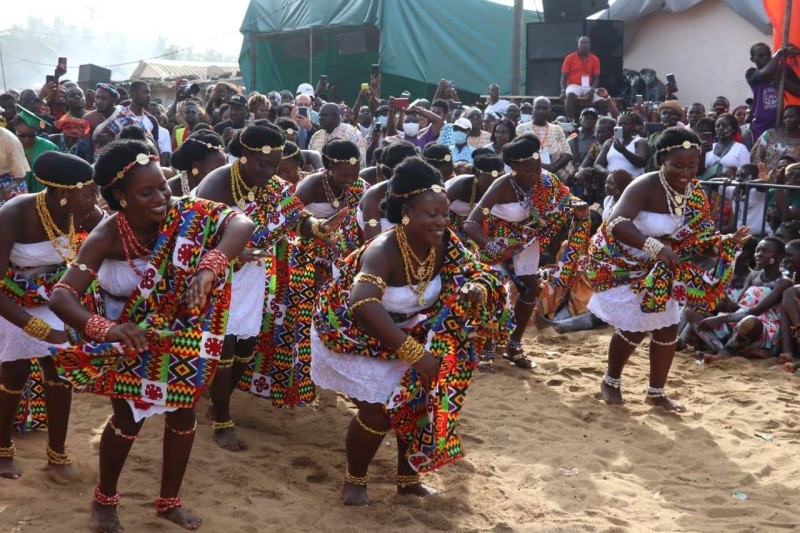
REFERENCE : TRANSAFRICA.BIZ
COTE D’IVOIRE
Region: villes de Grand-Bassam, Tiapoum ainsi que les villages de Nouamou , N’guiémé et Eboinda
Ethnic group : N’Zima (Akan)
Spirituality: Nyami
Abissa is the main festival of the N’Zima calendar of Grand Bassam, which celebrates the time of renewal and forgiveness. It is dedicated to Nyamie, the Akan name for the supreme deity. The festival lasts 14 days and during the entire period, professional activities or ceremonies such as weddings and funerals are suspended. The festival is animated by percussionists who guide the dances and rituals with a frenetic rhythm. The beating of the cosmic drum frees the N’Zima from all the usual restrictions and allows them to speak freely to the leaders and to each other. It is the moment of collective catharsis that leads to the renewal and rebirth of the entire community. Another particularity during Abissa is that men dress as women and vice versa. At the time of the accusation-repentance ritual, people disguise themselves to identify with those they have wronged. At the end of the ritual, all are forgiven for their mistakes
Balafon
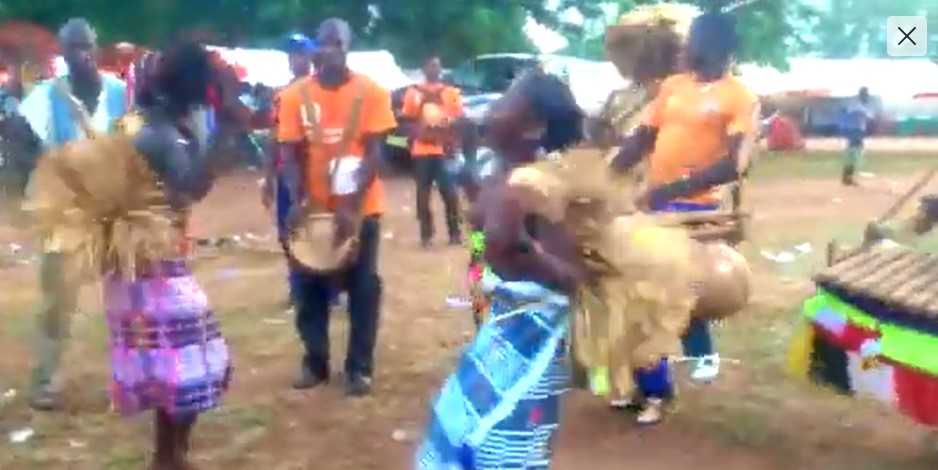
COTE D’IVOIRE, (MALI, BURKINA FASO)
Region: North
Ethnic group : Senoufo
Spirituality: Koulotiolo dieu puissant et Katielo, déesse-mère.
The balafon of the Senufo communities of Mali, Burkina Faso and Ivory Coast is a xylophone-type musical instrument. The cultural practices and expressions related to its use are recognized as a wealth that is part of the intangible cultural heritage of humanity by UNESCO.
In Senufo communities, the balafon is present at different times of collective life, whether it be festivals, prayers, esoteric rituals, or funerals. Its music is used to accompany the transmission of the community’s traditions, beliefs and values2.
Boloy
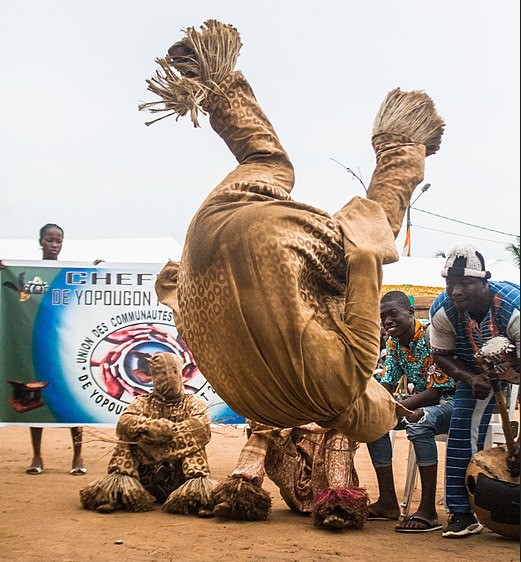
COTE D’IVOIRE
Region: North
Ethnic group : Senoufo
Spirituality: Koulotiolo dieu puissant et Katielo, déesse-mère.
Boloye is a sacred Senufo dance. It is also called the “dance of the panther-men” because the outfit worn by the dancer imitates the fur of these felines. This dance is performed to close the initiation rites. Calabashes or “bolons” in the Senufo language, on which are fixed skin ropes and rattles form the Boloye orchestra. The age of the dancers varies between eight and fifteen years, and their number between two and five. The panther dance or Boloye is made of acrobatics. The dancers jump sometimes on both feet, sometimes on a single foot raised very high
Djo-Djan
COTE D’IVOIRE
Region: ouest
Ethnic group : Dan
Spirituality:
Dans l’ouest du pays, Djo-Djan (la « danse des échassiers » en français) est pratiqué par les Dan,
Read La danse des échasses Un ryhme menacé
credit RESEAU IVOIRE
credit FAcebook : La Culture des Samôgô de Côte d’Ivoire
Flaly
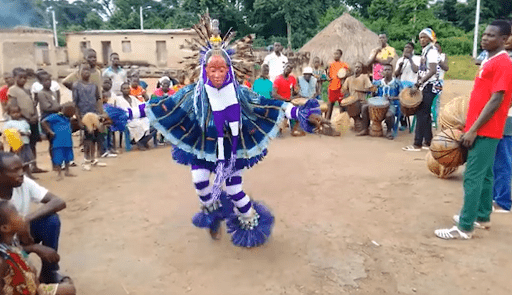
COTE D’IVOIRE
Region: Gohitafla
Ethnic group : Gouro
Spirituality: .
The flaly is a female face mask from the town of Gohitafla, in Ivory Coast and from the Gouro ethnic group whose name means “Peul woman”.
The Flaly mask has a feminine face with bird feathers on the nape of the neck. The dance is developed with the entire social body involving a dancer, an orchestra and an audience. The dancer is a proven artist initiated in bodily expression and agility of the feet. He wears bells on his feet associated with fibrous socks made of bark and a skirt made of these materials on the hip. The rest of his body is covered with a two-tone garment. A traditional loincloth with multi-colored patterns tied to the mask covers his bust. He holds oxtails in his hands.
Goli
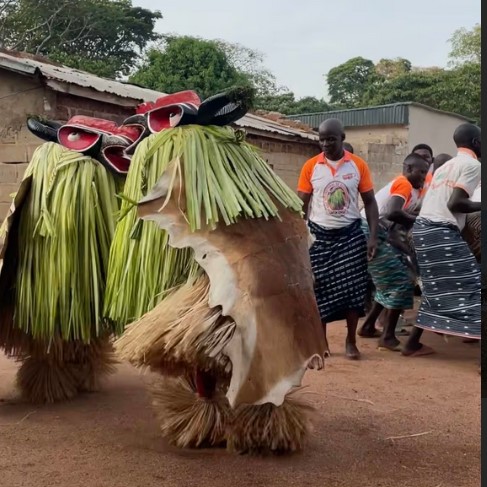
COTE D’IVOIRE
Region: Lake District
Ethnic group : Baulé
Spirituality: .
Goli is a sacred dance originating from the Wan which the Baoulés adopted in 1900
The mask is the central element of this dance, with its antelope horns, crocodile face and red disks symbolizing the sun.
Once highly sacred and reserved for special ceremonies, the Goli is now a tourist attraction in the Lake District
The dance is announced by a horn blown by a chosen person who will communicate with the mask. The other members of the orchestra accompany him/her with large calabashes called “Toha”
The lyrics of the songs accompanying the orchestra are in ethnic Wan.
The masks come out in pairs
REFERENCE : RIGHT FOR EDUCATION
Jugglers (Dance of)
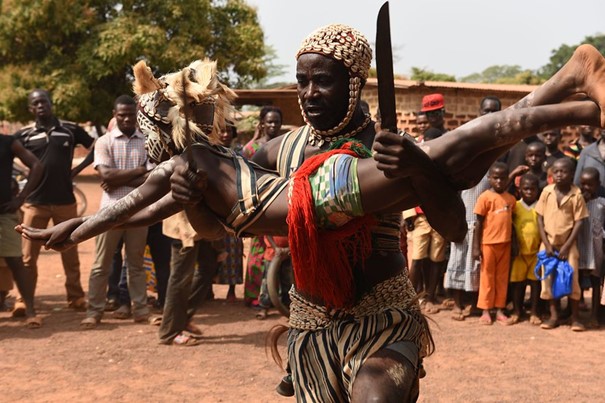
COTE D’IVOIRE
Region: West
Ethnic group : Guerés
Spirituality: God Creator communicating through masks
The knife dance, also called the “jugglers“, involves dancers who make children fly in the air, exposing them to the risk of falling on the knives: the strength and skill of the dancers on the one hand, and the imperturbability of the children on the other, exceed all imagination. The dance is rarely performed in the presence of foreign visitors.
Komian
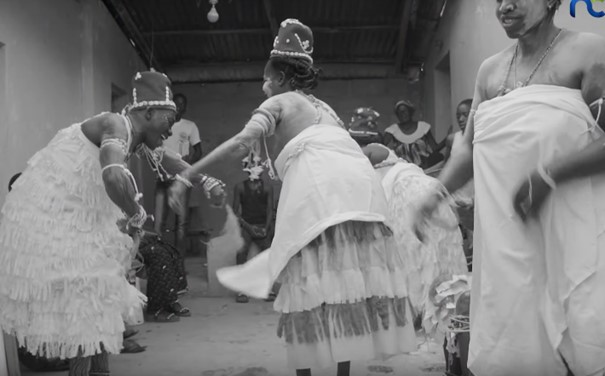
COTE D’IVOIRE
Region: South, Center , East
Ethnic group : Akan
Spirituality: Akan Religion
Among the Akans of Ivory Coast, the term Komian refers to trance, that is, to spiritual possession. The people called in this way are mainly women, who communicate with the spirit world through different divinatory mechanisms, including the throwing of shells, or by visions in the water or dance. The latter, certainly the most spectacular, is used especially on weekdays to solve the most complex problems: in front of the interlocutor, some of his relatives and the crowd of curious people rushing to the sound of the rhythm of the tamtams. The komian will try a ritual dance of invocation until falling into a trance. It is the manifestation of the spirit “at the opening of the mouth”, to which the priestess owes total self-denial, which will indicate the nature of the problem and the path to follow
See Video
NCI REPORTAGES | KÔMIANS, les dernières prêtresses
credit : LaNouvelle Chaine Ivoirienne
Ngoro
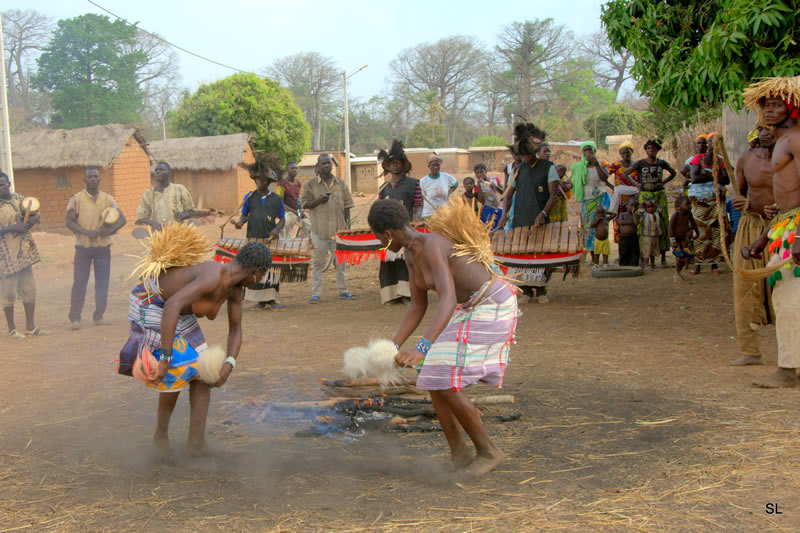
COTE D’IVOIRE
Region: North
Ethnic group : Senoufo
Spirituality: Koulotiolo dieu puissant et Katielo, déesse-mère.
La danse des jeunes vierges, appelée Ngoro, fait partie de l’initiation Poro réalisée par les Senufo.
Saapro
See video
Credit :Sotheca
Zaouli
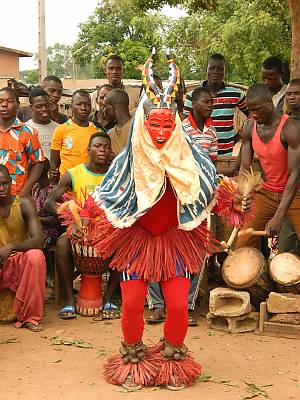
COTE D’IVOIRE
Region: Bouaflé and Zuénoula departments
Ethnic group : Guro
Spirituality: Akan Religion
Zaouli is a popular music and dance practised by the Guro communities of the Bouaflé and Zuénoula departments of Côte d’Ivoire. A homage to feminine beauty, Zaouli is inspired by two masks: the Blou and the Djela. In a single event, the practice brings together sculpture (the mask), weaving (the costume), music (the band and song) and dance. There are seven types of Zaouli masks, each translating a specific legend. The bearers and practitioners include sculptors, craftspeople, instrumentalists, singers, dancers and the notables (the guarantors of the community’s customs and traditions).
The viability of Zaouli is ensured through popular performances organized two or three times a week by the communities. The traditional chiefdom, the guarantor of traditions, also plays a key role in the transmission process and inter-village dance competitions and festivals offer further opportunities for revitalization..
Inscribed in 2017 (12.COM) on the Representative List of the Intangible Cultural Heritage of Humanity
